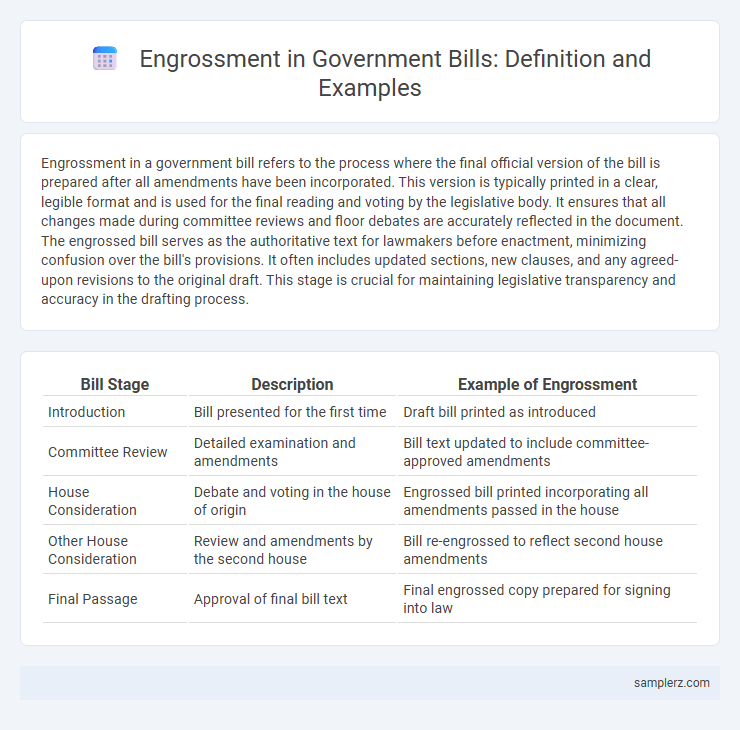Engrossment in a government bill refers to the process where the final official version of the bill is prepared after all amendments have been incorporated. This version is typically printed in a clear, legible format and is used for the final reading and voting by the legislative body. It ensures that all changes made during committee reviews and floor debates are accurately reflected in the document. The engrossed bill serves as the authoritative text for lawmakers before enactment, minimizing confusion over the bill's provisions. It often includes updated sections, new clauses, and any agreed-upon revisions to the original draft. This stage is crucial for maintaining legislative transparency and accuracy in the drafting process.
Table of Comparison
| Bill Stage | Description | Example of Engrossment |
|---|---|---|
| Introduction | Bill presented for the first time | Draft bill printed as introduced |
| Committee Review | Detailed examination and amendments | Bill text updated to include committee-approved amendments |
| House Consideration | Debate and voting in the house of origin | Engrossed bill printed incorporating all amendments passed in the house |
| Other House Consideration | Review and amendments by the second house | Bill re-engrossed to reflect second house amendments |
| Final Passage | Approval of final bill text | Final engrossed copy prepared for signing into law |
Understanding Bill Engrossment in Government
Bill engrossment in government involves preparing the final official copy of a bill after all amendments have been incorporated, ensuring accuracy before legislative approval. This process is critical in legislative procedures to maintain the integrity and clarity of the proposed law. Understanding bill engrossment requires recognizing its role in transforming draft legislation into an authoritative document for further consideration and enactment.
The Process of Bill Engrossment Explained
Bill engrossment involves preparing the final official copy of a legislative bill after all amendments have been adopted by a legislative chamber, ensuring the text is accurate and complete for final consideration. This process includes transcription of all modifications into the bill, verification for consistency, and formatting in accordance with legislative standards. Accurate engrossment is crucial for maintaining the integrity of the legislative record and facilitating a clear final vote.
Key Steps Involved in Bill Engrossment
Bill engrossment involves cloning the final version of a legislative bill after approval in one chamber, ensuring all amendments are incorporated accurately. Key steps include verifying the bill's text for consistency, formatting the document according to legislative standards, and certifying the engrossed bill before it advances to the next stage in the lawmaking process. This process guarantees clarity and legal precision essential for legislative review and enactment.
Notable Examples of Engrossment in Legislation
The engrossment process in legislation is exemplified by the U.S. Congress's handling of the Civil Rights Act of 1964, where the final engrossed bill incorporated all amendments before being sent for presidential approval. Another notable example includes the UK Parliament's procedural engrossment of the Brexit withdrawal agreement bill, ensuring all modifications from both Houses were reflected accurately. These instances highlight the critical role of engrossment in maintaining legislative accuracy and integrity before enactment.
The Role of Engrossment in the Legislative Process
Engrossment in the legislative process ensures that a bill incorporates all approved amendments accurately before final passage, serving as a critical step for legal clarity and procedural integrity. This stage involves preparing the official copy of the bill that reflects the exact text agreed upon by the legislative body, which is essential for preventing errors during voting and subsequent enactment. Engrossment affirms the legitimacy of the legislative document, facilitating transparency and accountability in government decision-making.
Differences Between Engrossment and Enrollment
Engrossment in a bill refers to the process of preparing the official copy of a bill in its final form after it has passed one chamber of the legislature, incorporating all amendments. The key difference between engrossment and enrollment lies in the stage of legislative approval: engrossment occurs after passage in one house, while enrollment happens after a bill passes both houses and is ready for the executive's signature. Engrossed bills include all textual changes from amendments within a single chamber, whereas enrolled bills contain the final, officially certified text agreed upon by both legislative chambers.
Engrossment Procedures in Different Governments
Engrossment procedures in different governments involve the formal preparation of the final official copy of a bill after it has been passed in one legislative chamber. In the United States Congress, the engrossed bill includes all amendments and is printed in a clean, consolidated format before being sent to the other chamber for consideration. Similarly, the United Kingdom's Parliament requires engrossed bills to be prepared with accuracy to ensure the text reflects all agreed-upon changes before receiving Royal Assent.
Legal Implications of Bill Engrossment
Engrossment of a bill involves preparing the final official copy after all amendments are integrated, ensuring legal accuracy and procedural compliance. This step solidifies the bill's text, preventing discrepancies during legislative approval and subsequent enforcement. Errors in engrossment can lead to legal challenges, delaying enactment and undermining regulatory clarity.
Historical Cases of Engrossment in Lawmaking
Historical cases of engrossment in lawmaking include the 1791 engrossment of the Bill of Rights, where meticulous hand-copying ensured an error-free final document for ratification. Another notable example occurred during the passage of the 1864 Coinage Act, where engrossment was critical to prevent numismatic inconsistencies in currency law. These instances highlight the importance of engrossment in maintaining legislative accuracy and legal clarity in government processes.
Importance of Accuracy During Bill Engrossment
Accurate engrossment of a bill ensures that all amendments made during legislative sessions are correctly incorporated into the final document, preventing legal misinterpretations and enforcement challenges. Precise transcription of legislative language upholds the integrity of the law and facilitates clear communication among government agencies, lawmakers, and the public. Errors during bill engrossment can lead to costly delays, judicial invalidations, and undermine public trust in the governmental legislative process.

example of engrossment in bill Infographic
 samplerz.com
samplerz.com